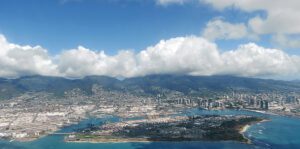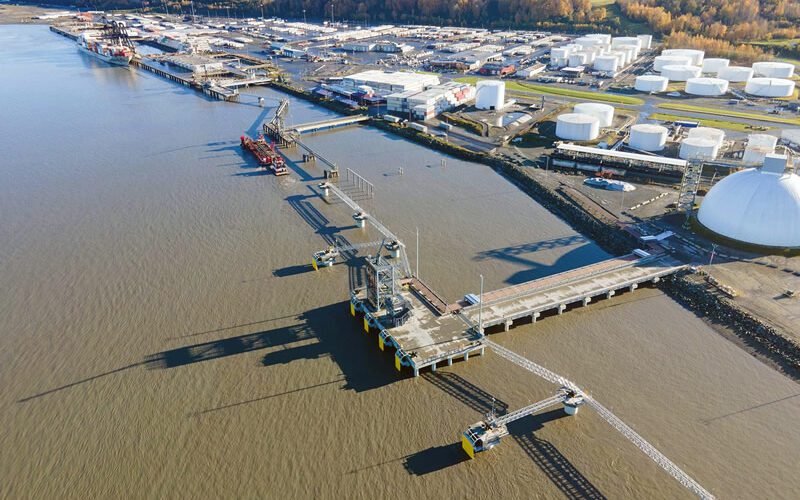
By Mark Edward Nero
Alaska and Hawaii may not be part of the contiguous U.S., but being physically apart from the rest of America doesn’t mean that their maritime industries are lying dormant, waiting for something to happen.
In fact, commercial maritime operations throughout the Aloha State and the Last Frontier have been busy planning infrastructure upgrades and performing terminal improvements.
Here are some of the noteworthy developments at major seaports in each state.
Port of Alaska
Perhaps the most notable news at the Port of Alaska came in the form of a fairly simple change. In June, a ceremony was held to officially rename the port the Don Young Port of Alaska.
The name honors the late Rep. Don Young (R-Alaska), who served in the U.S. House of Representatives from 1973 to 2022. Young, who died in March 2022 while on a flight home to Alaska, was at the time of his death the oldest and longest-tenured member of Congress.
During his political career, he had championed the port, which had been called the Port of Anchorage until a 2017 name change.
The Alaska Assembly formally approved renaming the port after Young in January.
In other news, the port in late May received the okay from the federal Maritime Administration (MARAD) to begin work on a massive modernization. The approval followed the municipality of Anchorage receiving a long-awaited environmental approval that unlocked tens of millions of dollars in grant funding.
The funding allows work to proceed on the first phase of the port’s North Extension Stabilization project, focused on land north of the port’s general cargo terminals to address “structural stability, seismic resilience and navigational concerns,” according to officials.
“(The) project will also create a safe and cost-effective path for replacing deteriorating cargo terminals,” the port stated in a 2022 grant application.
The site was originally built in 2008-09 to serve as an intermodal extension to the port, but was deemed a failure in 2012 when the port and contractors found that the North Extension area was too unstable for loading and that it could severely impair port operations in the event of an earthquake or some other catastrophic failure.
Since the project site extends into the water, any calamity would close the port’s navigation channel, thereby potentially closing off Alaska’s primary route to deliver goods to the state, the analysis found.
The ongoing stabilization project’s stated goal, port officials have said, is to create a physically safe, stable area for vessel maneuvering and make land available for future use. It’s part of a five-phase port modernization program to rebuild and repair the port. Anchorage has said that it aims to complete the full project by 2035.
As part of the program, construction of a petroleum and cement terminal and a new administrative building has been completed. Replacement of the port’s two cargo terminals is also planned, with work on the first terminal expected to begin in the summer of 2025.

Honolulu Harbor
Honolulu Harbor is the principal seaport in Hawai‘i and the state receives more than 98% of all goods through the harbor. Many containerized items are first shipped into Honolulu, then separated and trans-shipped to neighboring islands.
In April, the Hawai‘i Department of Transportation (HDOT) was awarded $5.25 million by the Federal Highway Administration to help pay for efforts to reduce emissions and improve operational efficiency at Honolulu Harbor’s Sand Island Terminal.
The project aims to reduce delays by 24 minutes per truck, according to HDOT. With an average of 100,000 truck trips to the terminal annually, CO2 emissions are expected to be reduced by 142 metric tons during each of the first 10 years, officials have said.
The total cost for the Sand Island Terminal Gating Project is $10.5 million; Honolulu-based Matson Navigation has committed to funding the portion not paid for by the grant.
The federal money was made available through the Reduction of Truck Emissions and Port Facilities Grant Program as part of the Bipartisan Infrastructure Law passed in 2022.
“Working in partnership with Matson Navigation Company, this project will replace gating technology and create a separate queueing area for truck exceptions that currently congest the flow of trucks on Sand Island Parkway,” Hawai‘i Director of Transportation Ed Sniffen said in a statement.
Similar gating technology is planned for the new 84-acre Kapālama Container Terminal, which is now under construction and expected to be completed in 2025.
Also at Honolulu Harbor, the U.S. Army Corps of Engineers performed maintenance dredging in July and August. It was the third maintenance dredging project undertaken by the Corps in Hawai‘i during 2024.
Maintenance dredging at Kaunakakai Harbor, located on the south-central coast of the island of Moloka‘i, and Kahului Harbor on the northern coast of the island of Maui, were completed on April 30 and June 7 of this year, respectively.
About 28,000 cubic yards of sediment were removed from Kaunakakai Harbor and about 142,000 cubic yards were removed from Kahului Harbor so vessels could safely enter, exit and maneuver within the locations.
Juneau
In August, the U.S. Coast Guard announced that it would homeport a commercially procured icebreaker vessel in Juneau, Alaska.
The Guard has said that it’s acquiring the Aiviq, a U.S.-flagged ship originally built to serve as an Arctic oil-exploration support vessel, which has an icebreaking capability sufficient to serve as a medium polar icebreaker after some modifications are made.
“The United States is an Arctic nation, and the Coast Guard is vital to providing presence in our sovereign waters and the polar regions,” Adm. Kevin Lunday, the Coast Guard’s vice commandant, said in an Aug. 14 statement. “(A)cquiring a commercially available polar icebreaker will enable the Coast Guard to increase our national presence in the Arctic, and homeporting this cutter in Alaska demonstrates the service’s steadfast commitment to the region.”
Currently, the Aiviq is the only U.S.-built commercial vessel meeting necessary icebreaking standards, according to the Coast Guard. Officials said in August that they anticipate the vessel reaching initial operational capability in two years.
In other news, Juneau’s port, which is popular for vacation cruises, made a significant move this past June to reorganize its cruise ship tourism industry.
Starting this year, the city of Juneau is only allowing five ships a day at the port in an effort to help mitigate congestion. And starting in 2026, the city plans to implement a cap on how many cruise ship passengers it allows into the city daily.
Under the plan, each Sunday through Friday the city would allow a maximum of 16,000 passengers. On Saturdays, which the city calls its slower port day, it would only allow 12,000 passengers.
The incoming rules are in response to the results of a telephone survey contracted by Juneau in fall 2023, in which 33% of residents wanted cruise ship passenger volumes to stay the same in the future; 31% wanted them slightly lower.
Juneau is expecting an average of 17,800 a day this year, but that would fall to 13,000 passengers daily if and when the new rules are implemented.
In other cruise port matters, the Royal Caribbean Group cruise line and Goldbelt Inc., an Alaska Native Corporation, announced in September that they’re working together to make Starlink satellite internet services available in an effort to combat network congestion for cruise passengers visiting downtown Juneau.
Users can gain access to the satellite-powered internet by logging onto the networks of participating downtown area businesses.
Additionally, the city and borough of Juneau is investing $1 million from marine passenger fees to make free Wi-Fi available in Juneau’s commercial district.
Kawaihae Harbor
In November 2023, the Port of Kawaihae, which is located on Hawai’i’s biggest island, was awarded a $23.46 million Port Infrastructure Development Program (PIDP) grant by the Maritime Administration for improvements that are expected to enhance the harbor’s operational efficiency and help reduce highway traffic congestion.
The grant is for the widening of Kawaihae Road in order to accommodate a left turn lane into the main port gate, and for concrete paving on 10 acres over asphalted portions in the cargo yard.
The project also includes new 80-foot mast lighting to replace current lighting equipment, the installation of conduit and raised transformer pads for expanded electrical power plugs for refrigerated containers and the relocation of the port office building and maintenance shed.
The state has said that the highway improvements would address community concerns by reducing traffic congestion caused by truck queues. The added turn lane could allow drivers who aren’t headed for the harbor to bypass the congestion.
“This multimodal project helps us meet many of our goals, such as improving quality of life and local food security,” HDOT’s Sniffen said.
“Without the support of these federal grant funds, we likely would not be able to complete this much-needed project for another decade,” said Deputy Director for Harbors Dre Kalili, also with HDOT. “The inclusion of federal resources in our projects means our commercial harbor system will remain a reliable lifeline for our state’s economy.”
The planned interior improvements would, according to the agency, enhance operational efficiency and safety to ensure goods move off the piers and to their final destinations as quickly as possible.
The grant award covers only 70% of the project’s total $33.9 million cost; HDOT said it expects to fund the balance of the project cost with revenues generated from harbor user fees.
The transportation agency also said it anticipates advertising the Kawaihae Harbor Improvements project to contractors in 2025, pending completion of the environmental review process.
Once the contract’s awarded, construction of the project is estimated to take two years, according to the transportation department.
Mark Edward Nero can be reached at mark@maritimepublishing.com

